La Oficina del Director de Inteligencia Nacional (ODNI, por sus siglas en inglés) ha presentado planes para el Consorcio de Datos de la Comunidad de Inteligencia (ICDC, por sus siglas en inglés), una plataforma centralizada diseñada para agilizar la adquisición de información comercialmente disponible (CAI) por parte de la Comunidad de Inteligencia. Esta iniciativa busca mejorar la accesibilidad y eficiencia de los datos en toda la Comunidad. No obstante, el ICDC ha generado un debate de corte tradicional, similar al que rodea la FISA, respecto a sus implicaciones para los derechos de privacidad de los ciudadanos estadounidenses y el posible deterioro de las protecciones constitucionales.
Comprendiendo la Iniciativa ICDC
El ICDC representa un esfuerzo coordinado por parte de la comunidad de inteligencia estadounidense para modernizar y centralizar la adquisición de CAI. Según los documentos oficiales de licitación, el ICDC se concibe como un “mercado para consultar e interactuar con los archivos de los proveedores”, con énfasis en un objetivo arquitectónico de “cero copias”, lo que significa que los datos se consultarán directamente en los sistemas de los proveedores en lugar de copiarse a servidores gubernamentales. Este enfoque pretende reducir la duplicación de datos y mejorar la eficiencia operativa. La plataforma está diseñada para operar completamente a nivel de computación no clasificada, permaneciendo toda su actividad en ese nivel. Ofrecerá múltiples opciones de interacción con los datos, incluyendo búsqueda a través de interfaces gráficas o web (GUI/WUI), llamadas API, acceso a datos en bloque y opciones de inicio de sesión en portales web externos. Se destaca el uso de código abierto y la adhesión a estándares de la industria como las especificaciones OpenAPI, a fin de garantizar flexibilidad y evitar la dependencia de un único proveedor.
Peligros Potenciales para Ciudadanos Inocentes
Si bien el ICDC tiene como objetivo mejorar las operaciones de inteligencia, plantea serias preocupaciones respecto a la privacidad de ciudadanos inocentes.
La amplitud de la recopilación de datos es problemática. La recolección masiva de información sobre personas completamente libres de sospecha o interés por parte de la Comunidad de Inteligencia es el proverbial elefante en la habitación. El ICDC facilita el acceso a cantidades inmensas de datos personales, incluidos registros de ubicación, información biométrica y actividades en línea, sin la necesidad de autorizaciones legales tradicionales, como las otorgadas por el Tribunal FISA. Esta recolección expansiva probablemente incluirá información sobre personas que no se encuentran bajo ninguna sospecha, constituyendo una clara violación de la privacidad.
La falta de transparencia y supervisión es casi tan preocupante como la propia actividad. La naturaleza centralizada del ICDC oculta de forma efectiva el tipo, alcance y profundidad de las actividades de adquisición de datos. Sin mecanismos de supervisión sólidos, existe un alto riesgo de uso indebido y extralimitaciones por parte de los organismos que componen la Comunidad de Inteligencia. Esto constituye, nuevamente, una posible violación de los derechos ciudadanos.
La adquisición incontrolada de CAI erosionará las protecciones establecidas por la Cuarta Enmienda. La investigación profunda de personas estadounidenses sin órdenes judiciales o aprobaciones legales desafía las protecciones que dicha enmienda otorga contra registros e incautaciones irrazonables. Las operaciones del ICDC sientan un precedente que permite eludir estas salvaguardas constitucionales.
Existe un alto potencial de abuso. La consolidación de datos personales en una plataforma centralizada incrementa el riesgo de accesos no autorizados y mal uso. En ausencia de estrictos controles de acceso y mecanismos de auditoría, aumenta significativamente la probabilidad de abuso de información sensible.
Equilibrio entre la Seguridad Nacional y las Protecciones Constitucionales
La justificación principal del ICDC es el fortalecimiento de la seguridad nacional mediante la mejora de las capacidades de inteligencia. Sus defensores argumentan que el acceso simplificado a la CAI permite una detección y respuesta más eficaz ante amenazas. No obstante, esto debe equilibrarse con los derechos fundamentales consagrados en la Constitución. La Cuarta Enmienda funciona como un control esencial del poder gubernamental, garantizando que los ciudadanos estén protegidos contra intromisiones injustificadas en su vida privada. El enfoque del ICDC hacia la adquisición de datos elude los procesos legales tradicionales y, por tanto, representa una amenaza significativa a dichas protecciones. Además, el potencial de desviación de misión genera inquietudes graves sobre las implicaciones a largo plazo para las libertades civiles. Sin límites claros y supervisión efectiva, el ICDC podría convertirse en una herramienta de vigilancia omnipresente, minando la confianza pública en las instituciones gubernamentales. El Panóptico habrá llegado.
Protección de la Privacidad
Si bien existen peligros, también hay medidas de control que pueden mitigar los riesgos asociados al ICDC. El establecimiento de marcos legales claros es un buen punto de partida. La legislación debe definir el alcance y las limitaciones de las actividades de recolección de datos, asegurando que se ajusten a las protecciones constitucionales y los derechos de privacidad. Se deben instaurar mecanismos de supervisión sólidos, similares a los que rigen bajo la FISA. Órganos de supervisión independientes deben estar facultados para monitorear las operaciones del ICDC, realizar auditorías y hacer cumplir el cumplimiento de los estándares legales y éticos. La transparencia debe ser la norma rectora. La comunidad de inteligencia debe estar obligada a emitir informes periódicos sobre las actividades de adquisición de datos, incluyendo los tipos de datos recopilados, los fines para los que se utilizan y las salvaguardas implementadas para proteger la privacidad. Dichos informes pueden y deben servir como base para entablar un diálogo con organizaciones de la sociedad civil, defensores de la privacidad y el público en general. La apertura en este aspecto fomentará un discurso más informado sobre el equilibrio entre seguridad nacional y los derechos de las personas y grupos afectados por la actividad OSINT.
El Consorcio de Datos de la Comunidad de Inteligencia representa un cambio significativo en la forma en la cual la comunidad de inteligencia estadounidense accede y utiliza la información comercialmente disponible. Si bien ofrece beneficios potenciales para la seguridad nacional, también conlleva riesgos sustanciales para la privacidad y los derechos constitucionales de los ciudadanos estadounidenses. Para garantizar que la búsqueda de seguridad no se realice a costa de las libertades civiles, es imperativo establecer marcos legales claros, supervisión rigurosa y prácticas transparentes que respeten los principios de una sociedad democrática.
Referencias
- Office of the Director of National Intelligence. (2025). OSINT Contract Framework. Obtenido de ODNI Document
- The Intercept. (22 de mayo de 2025). US Plans Data Portal to Expand Warrantless Surveillance. Obtenido de The Intercept
- Wired. (24 de mayo de 2025). Security News This Week: The US Is Building a One-Stop Shop for Buying Your Data. Obtenido de Wired
- Brennan Center for Justice. (s.f.). The Intelligence Community’s Policy on Commercially Available Data Falls Short. Obtenido de Brennan Center
- U.S. Senate. (2023). Privacy Act of 1974. Obtenido de Wikipedia
- U.S. Senate. (2023). Foreign Intelligence Surveillance Act. Obtenido de Wikipedia
- Wired. (20 de noviembre de 2023). Secretive White House Surveillance Program Gives Cops Access to Trillions of US Phone Records. Obtenido de Wired
- AP News. (28 de septiembre de 2023). A Key US Government Surveillance Tool Should Face New Limits, a Divided Privacy Oversight Board Says. Obtenido de AP News
- Time. (15 de marzo de 2024). Inside the White House Program to Share America’s Secrets. Obtenido de Time
- AP News. (10 de marzo de 2024). Book Review: ‘Means of Control’ Charts the Disturbing Rise of a Secretive US Surveillance Regime. Obtenido de AP News


